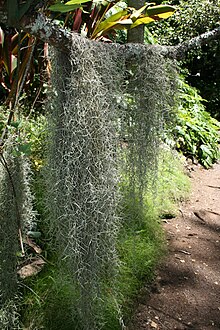Tillandsia usneoides
| Spanish moss | |
|---|---|
 |
|
| Scientific classification | |
| Kingdom: | Plantae |
| (unranked): | Angiosperms |
| (unranked): | Monocots |
| (unranked): | Commelinids |
| Order: | Bromeliales |
| Family: | Bromeliaceae |
| Genus: | Tillandsia |
| Subgenus: | Diaphoranthema |
| Species: | T. usneoides |
| Binomial name | |
|
Tillandsia usneoides (L.) L., 1762 |
|
| Synonyms | |
|
|
Spanish moss (Tillandsia usneoides) is an epiphytic flowering plant that often grows upon larger trees in tropical and subtropical climates, native to much of Mexico, Bermuda, the Bahamas, Central America, South America, the southern United States, and the West Indies as well as being naturalized in Queensland (Australia) known as "grandpas beard" and in French Polynesia. In the United States where it is most known from, it is commonly found on the southern live oak (Quercus virginiana) and bald-cypress (Taxodium distichum) in the lowlands, swamps, and savannas of the southeastern United States from Texas and Florida north through southern Arkansas.
This plant's specific name usneoides means "resembling Usnea", and it indeed superficially resembles its namesake Usnea, also known as beard lichen, but in fact Spanish moss is neither a moss nor a lichen. Instead, it is a flowering plant (angiosperm) in the family Bromeliaceae (the bromeliads) which grows hanging from tree branches in full sun through partial shade. Formerly this plant has been placed in the genera Anoplophytum, Caraguata, and Renealmia. The northern limit of its natural range is Northampton County, Virginia, with unsubstantiated colonial-era reports in southern Maryland where no populations are now known to be extant. The primary range is in the southeastern United States (including Puerto Rico), through Argentina, growing where the climate is warm enough and has a relatively high average humidity. It has been introduced to similar locations around the world, including Hawaii and Australia.
...
Wikipedia
